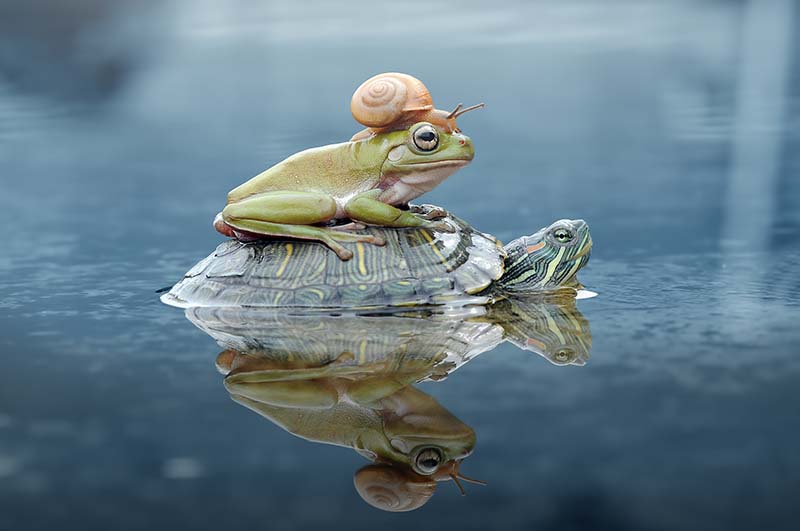
People often ask if you are a cat person or a dog person, but has anyone ever asked you if you are a turtle or a frog person? Probably not! But they are definitely out there, and it would therefore be good to know if these unusual pets can share their habitat.
The answer is “maybe” because only certain species of frogs and turtles can live together, but it’s generally not recommended.
In this guide, we’ll explore the lives of turtles and frogs living together, along with risks, tips, and a safety guide.
Can Frogs and Turtles Live Together?
In the wild, some turtle species will certainly live in the same region as some frog species, and tolerate the same types of habitat. Both are ectotherms, meaning that their body temperature is dictated by their environment. In most cases, they both prefer habitats that are moist, and for temperatures to be in the same sort of range.
BUT! In many cases, turtles eat frogs, so they may not make the best roommates. Also, frogs and turtles are solitary animals and prefer their own company, so putting them together in the same enclosure or terrarium could be a constant stressor for both, with one eventually being attacked or becoming prey.
As a rule, it’s better to house a pet frog and a pet turtle separately. Both animals are opportunistic predators, meaning they will eat anything they can fit into their mouths, and you’ll be running a real risk of one eating the other. Also, both are omnivores, meaning they both eat animals and plants, which could provoke competition that could end in disaster.

What Species-Specific Frog and Turtle Can Live Together?
We mentioned at the beginning of this article that certain species-specific turtles and frogs can live together, but particular measures have to be taken for success, and even then, we wouldn’t recommend it.
Box Turtles are land turtles that can possibly be housed with a frog. They are clumsy swimmers, which would make it hard for one to catch the frog. And since Box Turtles are clumsy swimmers, this allows your frog to inhabit the deeper part of the aquarium, but you’ll still be running a risk.
Another factor to consider is that frogs carry toxins and have poisonous glands called the parotid gland, which help ward off predators. The glands release poisonous fluids that cause a burning sensation, with the eyes and mouths of the unfortunate one often affected—this could pose a health risk for your turtle if the frog has too many toxins in the glands. Green tree frogs have milder toxins, which make them a possible candidate for housing the two together, but again, it’s not recommended.
The 3 Safety Tips for Housing a Frog and Turtle Together
While we still do not recommend housing the two species together, there are certain measures you can take to make it as safe as possible should you attempt having both as pets. Let’s take a look.
1. Tank Space
Most tanks will not be big enough to accommodate both living together without running into each other. Both species require a large amount of space to forage, swim, and hide; without these necessities, they will become stressed. In a nutshell, you cannot safely house the two in a tank enclosure.
If you are fortunate enough to have a very large enclosure (we’re talking about walk-in sized), this may create an opportunity for you to house these species together, but there will always be the risk of predation.

2. Stress
Depending on the size, the turtle may not attempt to eat the frog; however, they will be in constant battle and competition for food, which causes stress. The tension may lead to an attack eventually, which, again, is not worth the risk. You want your pet frog and pet turtle to be happy and healthy, and housing the two together is not ideal. If one is bigger than the other, an attack is likely.
Stress is one of the major killers of exotic pet species, so out priority should always be on minimizing stress, not adding to it.
3. Food
While both species are omnivores, they may not have the same mealtime requirements. For example, one may eat only every other day, while the other needs food each day. This can lead to one being overfed or underfed. It’s best to house them separately in order to feed the appropriate frequency for each species.

What About Other Combinations?
If you keep the above considerations in mind, particularly regarding the size of the enclosure, there are some reptile and amphibian combinations that can be housed together relatively peacefully. For example:
Avoid any species with poison glands or that are particularly predatory (eg. Cuban tree frogs).
Final Thoughts
As you can see, it’s neither ideal nor safe to house frogs and turtles together. The risk is not worth the attempt, and you’ll be putting both animals in potential danger, not to mention the two will be under constant stress. It’s best to house them separately if you want both as pets.
It is worth remembering that most reptiles and amphibians are not social creatures, and will, in general, feel more stressed with company than without it.
Featured Image Credit: Agus Fitriyanto Suratno, Shutterstock
The post Can Frogs and Turtles Live Together? Vet-Reviewed Risks & Safety Tips appeared first on Pet Keen.




